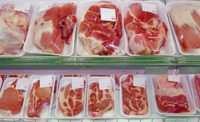Ingredients
Clarifying 'clean label'
Ingredients that product developers add to meat and poultry to enhance taste, quality and texture are under review as more consumers and merchandisers seek wellness-oriented options.

The growing focus by shoppers and retailers on meat and poultry with clean labels is likely to trigger changes in substances that help to enhance product quality, including gums, binders and emulsifiers.
While processors often include such additives to bolster the taste, texture and protein content of products, more developers are looking at alternatives in response to the increasing consumer demand for ingredients that they perceive to be healthier, analysts note.
“As U.S. consumers call for clean labels, which do not have any regulatory status or definition, food scientists and producers are challenged to simplify the required ingredient declaration statement,” says Roger A. Clemens, adjunct professor of pharmaceutical sciences and associate director of the regulatory science program at the University of Southern California School of Pharmacy in Los Angeles. “This simplification is possible in part through innovative food technologies.”
Ingredient suppliers have been “cognizant of the consumer trend for clean-label ingredients that are familiar to them and not ‘chemical sounding,’” says Andrew Milkowski, adjunct professor in the Meat Science and Muscle Biology Laboratory in the Department of Animal Sciences at the University of Wisconsin in Madison. “This has resulted in using more minimally processed materials that can satisfy those desires while still providing functionality.”
Determining the appropriate elements to include in meat and poultry necessitates testing a range of ingredients in a structured manner, he says.
Milkowski notes, however, that “proper dispersion into the product can be a challenge, especially for ingredients that are hard to hydrate and used in very small amounts and in whole-muscle products.”
Mix and match
The amount and type of gums, binders and emulsifiers to incorporate, meanwhile, will vary in accordance with the specific protein and the unique merchandising dynamics of a particular market, says Jonathan Campbell, extension meat specialist and assistant professor in the Department of Animal Science at Penn State University, in University Park.
Use of the additives, for instance, is common in Latin America for such items as boneless hams and sausages, he notes, as proteins in many economically depressed countries often contain less meat than similar products in the U.S. because of merchandisers’ intent to constrain prices. Adding extra proteins and binders to formulations can enhance the composition of meat and poultry and make selections, such as deli meats, easier to slice, Campbell says.
Yet, because U.S. regulations require the elements appear on ingredient statements, Americans looking for meats and poultry with cleaner labels are more likely to avoid products with unfamiliar additives, Campbell says, even though shoppers may mistakenly perceive the binders, gums and emulsifiers as being unhealthy.
Though there are no organic certifications for the additives, more ingredient suppliers still target the wellness-conscious shopper by experimenting with natural formulas, which might include using fruit or vegetable extracts to help with color development or stability, while also looking to leverage antimicrobial properties, he says.
Processors typically can determine the gums, binders and emulsifiers that are most appropriate for particular meat and poultry products by soliciting input from ingredient suppliers as well as from their own research and development efforts, Campbell says.
The biggest merchandising challenge, meanwhile, is meeting evolving buyer expectations, which could demand the use of higher priced additives while still providing affordable meat and poultry options, he says.
“Customers want the highest quality for the lowest price, but that is not always feasible from a production standpoint,” Campbell says.
An effective antidote
Because processors primarily use gums, binders and emulsifiers in proteins with casings or products they mold into specific shapes, sizes or dimensions, whole-muscle meat and poultry, including steaks and chicken breasts, are usually free of the additives, he says.
Yet the substances are important as they better enable meat and poultry processors to form and fabricate proteins so that they stick together in a variety of cooking environments, such as when frying, baking and microwaving, while maintaining appropriate levels of moisture and texture, Clemens says.
“The ingredients also help with profits because the binders and additives can extend the shelf life of products, which reduces waste as well as out of stocks,” says Kari Underly, principal of Range Inc., a Chicago-based fresh meat consulting and education firm. “The use of emulsifiers in such items as hot dogs and sausages are getting to be trendier.”
Most retailers, meanwhile, rely on processors to incorporate gums, binders and emulsifiers into proteins instead of adding the ingredients at stores’ meat departments, Underly says. Such a procedure helps to ensure a more consistent eating experience regardless of the location that sells a specific meat and poultry product, while eliminating the greater food safety threat from in-house production, she says.
For best results, meat and poultry processors should use particular additives in accordance with the specific protein and fat contents of meat and poultry selections, Underly says, which typically requires experimenting with ingredients.
Such testing also will better enable researchers to incorporate substances into meat and poultry that consumers will perceive to be healthier, says Jeff Sindelar, associate professor and extension meat specialist in the Department of Animal Sciences at the University of Wisconsin in Madison.
Product developers will likely consider replacing traditional binders, extenders and emulsifiers, including the sodium phosphates that processors often use for greater water retention, with ingredients that have similar functionality but different compositions, he says.
But because the traditional ingredients “have very specific values or characteristics that are difficult to replace,” processors must assess the potential gains or losses from substitutions before altering their use of substances, Sindelar says.
Among the potentially “cleaner” options are ingredients that use fiber from the pulp of fruit, he says, which might replace a starch or carrageenan.
“Meats with cleaner ingredients may be less functional because of their lack of chemical and physical manipulation, so developers must have a strong understanding of the potential additives and test for efficacy,” Sindelar says. “The most popular ingredients are those that are most functional and cost effective, but some issues, such as allergenicity, are driving product developers to exclude or carefully consider the use of particular elements.”
A tough audience
Yet, even as producers develop more meat and poultry selections with fewer ingredients, many consumers still contend that any form of food processing is unacceptable, Clemens says.
“Regardless, it is clear that reducing food waste, advancing food technologies and minimizing food ingredients are three critical areas that deserve increased consumer education,” he says.
Sindelar notes, meanwhile, “there (haven’t) been any great recent breakthroughs in product development so more work has to be done for the use and efficacy of ingredients for meat and poultry.” The highest quality selections will likely contain a combination of substances rather than just having single elements for binding, emulsifying, extending, water holding and texture enhancements, he says.
Among the major challenges of incorporating cleaner elements in proteins, Sindelar says, is ensuring there will be no changes to a product’s color, texture and physical or visual appearance by switching additives, he says.
In addition, ingredient suppliers’ reluctance to divulge their research and development activities may make it difficult to create standard additives that processors throughout the sector can use for enhancing specific elements on particular meat and poultry products, Sindelar says.
Nevertheless, the increasing shopper and merchandiser focus on wellness will likely keep the demand for cleaner meat and poultry labels in the spotlight and prolong the search for gums, binders and emulsifier alternatives that have a healthier halo, analysts say.
“There remains the trend by shoppers of not wanting words on labels that they cannot pronounce,” Underly says. “For many consumers, the cleaner the label, the better. But acceptance by shoppers will also depend on price as clean label products are typically more expensive than traditional selections.” NP
Looking for a reprint of this article?
From high-res PDFs to custom plaques, order your copy today!








